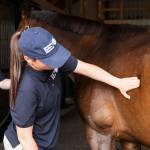Accurately Estimating Body Weight of Horses: Why and How

Up to half of all horses are considered overweight, and about 30% of these are obese. This obesity epidemic is more than unhealthy; for some horses, it is a welfare issue. Animals that are overweight are at risk of equine metabolic disease (EMD) and hyperinsulinemia-associated laminitis (HAL). Further, overweight horses also have impaired reproductive performance and musculoskeletal disorders such as osteoarthritis and are prone to heat stress and decreased performance.
Reasons to Know Your Horse’s Weight
Accurately assessing a horse’s body weight is important for dosing medications such as dewormers (anthelmintics) and nonsteroidal anti-inflammatory drugs. It also allows owners to calculate feed requirements, which is increasingly important with the surge in EMS. Horses with EMS (and therefore insulin dysregulation) should be fed specific amounts of forage, frequently based on percent body weight.
“For horses that need to lose weight, or at least not gain any more weight, their daily forage intake should be restricted to 1.25-1.5% body weight on a dry matter basis,” explained Kathleen Crandell, Ph.D., a Kentucky Equine Research nutritionist. “In comparison, a horse in good condition can consume up to 2% of their body weight per day in forage.”
This means that for an overweight 1,100 lb (500-kg) horse that needs to lose weight, it should only be offered 1.5% of forage or 16.5 lb (7.7 kg). This is much less forage than the 22 lb (10 kg) a 1,100-lb (500-kg) horse in good condition can have. Choosing a low-calorie roughage source may allow the horse to consume more hay without additional calorie intake.
Without a weight scale, owners have the option to estimate body weight based on weight tapes; however, even weight tapes can underestimate a horse’s weight.
Assessing Condition
In addition to estimating weight, owners are also encouraged to evaluate body condition to determine whether their horse is overweight.
“We should use accurate and repeatable ways of assessing a horse’s body condition to determine the efficacy of weight-management strategies and to know if more aggressive efforts are required,” advised Crandell.
Several barriers prevent owners from identifying overweight and even obese horses. First, owners often do not know what a healthy horse looks like.
“This is likely a consequence of the perception that rounder horses look healthier than angular horses. Some breeds are thought to be unattractive unless they have excessive amounts of fat cover, and some judges even prefer overweight horses and ponies in the show ring. This attitude carries right down to horse owners who do not want others to think they are not caring for their horses by allowing them to get too skinny,” Crandell said.
Second, surveys show that owners find the body condition score chart challenging to use and often underestimate their horse’s body condition by one or two points.
“For example, using the Henneke system, each point on the nine-point scale is approximately 40-50 lb (18-23 kg) for a 1,100-lb (500-kg) horse. So, if a horse is an 8 instead of an owner-reported 5, then this means the horse is 135 lb (61 kg) overweight,” Crandell said. Keep in mind that the amount of weight represented by one BCS unit varies with the size of the horse.
Other Assessments
Owners can also use the cresty neck score (CNS), which is a measure of fat accumulation in the neck, rather than body-wide fat cover like BCS. The CNS scale ranges from 0 (no crest) to 5 (a very large crest). Neither of these scales, however, takes into consideration the horse’s muscling.
“A horse’s muscularity can vary based on breed, age, fitness, and nutritional status,” she said.
The muscle atrophy scoring system (MASS) can be used to describe horses as having no muscle atrophy (a score of 1) to severe muscle atrophy (a score of 4). However, according to one recent study, many owners have little awareness of how well-muscled their horses are.*
New Techniques Needed
As Urbanek and Zebeli noted, “Estimation of body condition and body weight under practical conditions is not easy.”*
Their research focuses on using various morphometric measurements such as height at withers, circumference of the chest, cannon bone circumference, body length, body circumference, as well as BCS, CNS, and MASS to better estimate body weight.
Their work shows that there are other ways to accurately estimate the amount of condition on a horse without depending on the traditional body condition scoring charts, which may be more suitable for the lesser common breeds.
Balancing a Weight-Loss Diet
Considering the severe health risks associated with obesity, the importance of achieving and maintaining ideal body weight or body condition cannot be emphasized enough. Yet, there are challenges in feeding a balanced diet when having to control the amount of dietary intake.
To overcome the nutritional shortcomings of hay-only diets or low concentrate intake—the ration most overweight or obese horses should be on—be certain to offer a well-formulated ration balancer or vitamin and mineral supplement.
*Urbanek, N., and Q. Zebeli. 2023. Morphometric measurements and muscle atrophy scoring as a tool to predict body weight and condition of horses. Veterinary Science 10(8):515.








